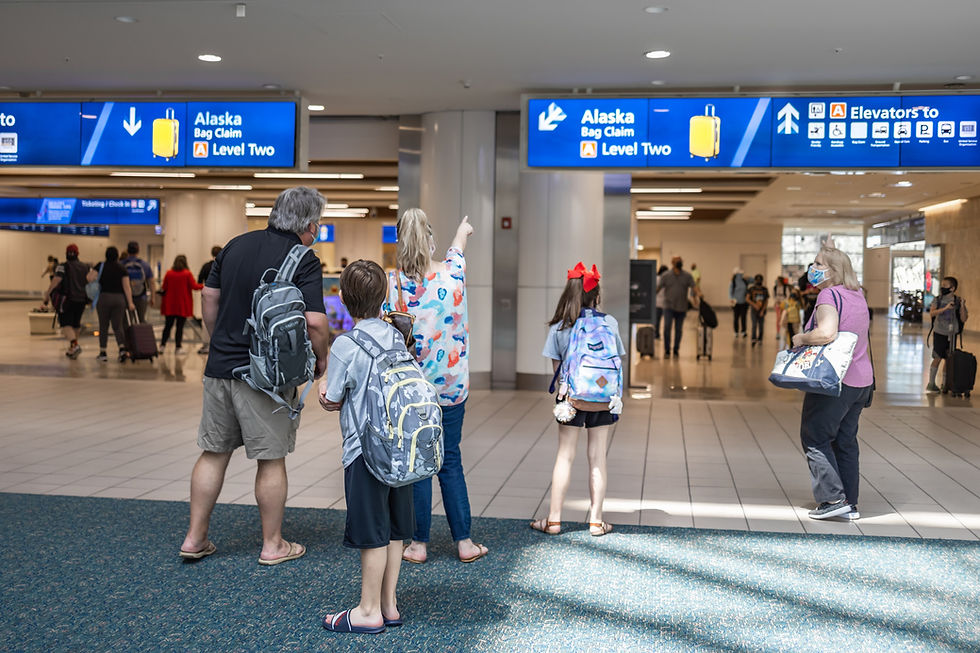Transforming Airport Passenger Experiences Is Easier with Content-First Strategies
- Abagael Rudock

- Aug 28
- 3 min read
Managing airport passenger experiences is a complex, cross-functional challenge that spans departments, technologies, tools, and touchpoints. While hardware and infrastructure have taken center stage in the past, Synect’s content-first strategies are now in the spotlight.
Transforming the passenger experience can’t happen in a silo. We have seen first-hand how airports can elevate their experiences by aligning strategy, content planning, systems, and stakeholders. Doing so requires answering two questions early: what needs must our content strategy address? And who owns the content strategy?
Read on for the answer to those questions. If you want to go even deeper, join us at FTE Global 2025 in Long Beach and see our panel, Smarter Signage Starts Here: Content, Strategy, and Systems that Deliver, at 11:30 AM on Thursday, September 11th.

Content Strategy Needs Clear Ownership
Content strategy affects every aspect of the passenger experience. It shapes how passengers navigate the environment, interact with security, explore concessions, and engage with the airport.
Without clear leadership and cross-department collaboration, content can become fragmented, inconsistent, and ineffective.
The best strategies are collaborative, proactive, and built to serve passengers, internal stakeholders, and third parties like TSA, concessionaires, the local community, and more. While every airport will see different teams come together to create and support their content strategy, we’ve seen some trends in how each department contributes:
Marketing helps define tone, branding, and messaging.
Customer Experience surfaces passenger needs and feedback.
IT ensures systems are scalable, secure, responsive, and multipurpose across the airport
TSA shares insights and requirements to improve checkpoint flow.
Wayfinding identifies key decision points and signage needs.
Concessionaires highlight special offers and key amenities.
Every department brings in unique priorities. When they’re aligned with a shared strategy, everyone benefits—especially passengers.
Best Practices for Managing Airport Content & Strategy
Several key initiatives help airports maintain control of their content strategy:
Establish a cross-department governance committee: bring together representatives from marketing, IT, operations, customer experience, and more to guide strategy creation and decision-making.
Define roles for creation, approval, and deployment: clarity reduces bottlenecks and ensures content is timely and accurate.
Prioritize transparency and collaboration: open communication keeps teams aligned and responsive to passengers’ needs.
Implement a flexible CMS: leading airports are moving away from legacy digital signage solutions and towards modern digital content management systems, like Passenger360®, to support dynamic, real-time, airport-wide communication.
Why Governance is Critical for Scalable Strategy
Aligning on shared goals, key objectives, a clear vision, and a plan of record ensures that every piece of content enhances the passenger experience. Without it, airports risk making reactive, ad-hoc changes that will weaken their content.
Whether airports are opening a new terminal or rolling out updates for existing displays, a structured approach ensures that all content is purposeful, cohesive, and aligned with their long-term goals.

Every Department Shapes the Airport Passenger Experience
The most successful airports treat content strategy as a shared responsibility. When departments collaborate, content becomes a tool for transformation. From reducing stress at security to boosting engagement with concessions, content-first strategies help airports influence passenger behavior, drive ROI, and deliver the seamless, efficient experiences passengers have come to expect.
Join us at FTE Global 2025
Want to see how leading airports are putting these ideas into action? Join us at FTE Global 2025 for this year’s presentation, Smarter Signage Starts Here: Content, Strategy, and Systems that Deliver.
We’ll be live on stage at 11:30 AM on September 11th —but if you can’t catch the panel, there are plenty of other opportunities to connect with our team:
📍 See us at Booth D5
📆 Schedule time using the FTE App Sept. 9-11, 2025
🚶Join the Accessibility Tech & Innovation Briefing Tour on September 10th at 3:30 PM
Send us a note today if you’d like to chat with our team.


